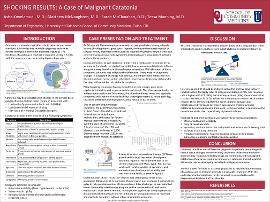| dc.description.abstract | INTRODUCTION: Malignant catatonia is a life threatening disease and can be difficult to distinguish from other disorders including delirium, neuroleptic malignant syndrome, or exacerbation of mood and psychotic disorders. Catatonia includes three or more of the following symptoms: stupor, catalepsy, waxy flexibility, mutism, negativism, posturing, mannerism, stereotypy, agitation, grimacing, echolalia and echopraxia. Malignant catatonia can include autonomic instability (fever, hypertension, tachycardia), severe muscle rigidity, and nonspecific laboratory findings of leukocytosis and elevated creatinine kinase. This syndrome can lead to severe morbidity and mortality if not promptly treated.
CASE DESCRIPTION: An 18 year old African American male with no past psychiatric history and a family history of schizophrenia presented with new onset of mania and psychotic symptoms including bizarre, disorganized behavior and emotional outbursts. He initially responded to olanzapine for control of his symptoms, but over time stopped the medication due to side effects. As a result, he had a return of his psychotic symptoms along with waxy flexibility, sleeping for nearly 20 hours each day, restricted affect with minimal speech, and a refusal to eat or drink. The patient responded to a lorazepam challenge putting catatonia on the differential. The patient needed high doses of lorazepam to help with catatonia and severe symptoms of mania and psychosis, including hypersexual behavior, agitation, combativeness, and bizarre and disorganized thought content. With his symptoms, hypertension, and elevated creatine kinase, electroconvulsive therapy (ECT) was initiated for treatment of malignant catatonia. He responded well to six sessions with total resolution of symptoms. After discharge, he was admitted to our community assertiveness program and he continued to do well with low dose lorazepam, mood stabilizer and antipsychotic which were added for maintenance treatment of his mood and psychotic symptoms. Over several months, his outpatient psychiatrist slowly tapered the lorazepam and he continues to have good control of his mood and psychotic symptoms with no return of catatonia symptoms.
DISCUSSION: First line treatment of catatonia is scheduled doses of lorazepam. However, in severe cases such as malignant catatonia, ECT should be initiated as soon as possible. The response rate to malignant catatonia is higher with ECT versus treatment with lorazepam alone. On review of case reports, it is beneficial to start ECT within five days of onset of symptoms to lower mortality rates. It is important to have catatonia on a differential diagnosis for patients presenting with mental status changes to ensure timely treatment is initiated. | en_US |

